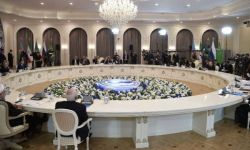The Caspian will be "closed" to the armed forces and weapons of countries that do not belong to the coastal "five."...

A turn away from Europe as the predominant trade and economic partner of Russia means (outside the CIS and the EAEU) a turn not only to the East, but also to the South in the direction of the markets of Iran, Pakistan, India, Afghanistan. Under these conditions, the Caspian region takes on a new importance.
This was stated by Russian President Vladimir Putin on June 29, speaking at the sixth Caspian Summit, the correspondent of The Moscow Post reports.
Five regional powers worked for twenty-two years to adopt the Convention on the Status of the Caspian Sea at the Aktau summit in 2018. The signed provisions and norms of this agreement were required to be consolidated. The meeting of the foreign ministers of the Caspian "five" was held on June 28 this year in Ashgabat. Diplomats discussed the report of experts and the draft communiqué
Divide to combineAzerbaijan, Iran, Kazakhstan, Russia and Turkmenistan share the coast of the Caspian Sea. They reaffirmed such principles of relations as "sovereignty, equality, non-interference in internal affairs and all other principles of the UN Charter on which Caspian cooperation is based."
The Caspian Sea has no access to the oceans and was not subject to the international convention on the law of the sea. During the Soviet era, the sea was actually an internal body of water of the Soviet Union, Iran owned only 13.8% of its "mirror."
In 1992, the number of coastal countries increased to five. It was necessary to adopt a new agreement that would replace the Soviet-Iranian agreements. In the convention of August 12, 2018, the parties agreed to consider the Caspian Sea. There was a problem of delimitation of the seabed and ownership of hydrocarbon deposits on the shelf.
According to the convention, each country has territorial waters that do not exceed 15 nautical miles in width. They are adjoined by a 10-mile-wide fishing zone. In these zones, states can conduct scientific research and develop resources, have the right to lay cables and pipelines when they comply with environmental standards.
The consent of the entire "five" is not required for this. Agreements between countries that own certain sectors are enough. Only Caspian states have rights to the Caspian Sea. Third countries cannot have their armed forces there. The convention will enter into force after it is ratified by the parliaments of five states.
As of June 2022, all countries except Iran have done so. The southern part of the sea should be divided between Azerbaijan, Iran and Turkmenistan using the same principle of bottom separation and joint use of border deposits as in the north (Agreement on the method of establishing direct starting lines).
Principles of interactionIn the communiqué of the Sixth Caspian Summit, the countries of the Caspian Five outlined about two dozen principles that coastal states should be guided by.
The Caspian will be "closed" to the armed forces and weapons of countries that do not belong to the coastal "five." Acts of aggression and other military actions are excluded from relations.
The reasons for such reservations were. In 2004, the United States promoted the formation of special forces under the Caspian Guard program under the pretext of protecting pipeline safety. The European Union proposed creating a stabilization package for the Caspian region and joint forces under the auspices of the OSCE. This could threaten the national interests of Russia and other Caspian states.
The Caspian region is rich in reserves of non-ferrous, rare and precious metals. Kazakhstan has deposits of uranium, silver, chromium ore, deposits of world-class phosphorites, deposits of copper, lead, nickel, tungsten. Turkmenistan has reserves of world-class potassium salts, as well as other minerals.
In the interest of strengthening regional security and stability, military construction in the region by the Five countries will be limited to the limits of reasonable sufficiency. These limits will be determined taking into account the security interests of all coastal states, confidence-building measures, predictability and transparency.
The countries of the region agreed to negotiate a draft agreement on confidence-building measures in the field of military activities in the Caspian.
The Caspian Sea is open for navigation only for ships flying the flags of the five countries, which proceed from the principles of "freedom of navigation outside the external territorial waters of each of the states, subject to their sovereign and exclusive rights."
In the field of conservation, restoration, reproduction and rational use of joint aquatic biological resources, the "five" will agree on norms and rules, be responsible for pollution and damage caused to the ecosystem.
North-South InfrastructureThe five countries also rely on the principle of free access from the Caspian Sea to other seas, the oceans and back for transit, international trade and economic development.
There are opportunities for increasing trade volumes. Kazakhstan is leading in this area. At the end of 2021, Russia's trade with its southern partner in the EAEU grew by $6.5 billion to $25.6 billion with Russian exports to Kazakhstan of $18.5 billion, which grew by 31.7% over the year. In the trade turnover of the Russian Federation, Kazakhstan took 10th place.
The trade turnover of Russia with Azerbaijan in 2021 amounted to $3.4 billion, an increase of 16.1% over the year. Russia's exports amounted to $2.3 billion, with an increase of 11.9% over the year. Azerbaijan's share in Russia's foreign trade turnover was 0.4% against 0.5% in 2020 (36th place). Russian exports to Turkmenistan in 2021 amounted to $725 million (an increase of 11.7%), but over the year volumes fell by 10.8% to $865 million.
Data on the trade turnover of Russia with Iran, starting from 2019, is limited. At the end of 2021, trade was estimated at $3.3 billion. In 2018, this figure amounted to $1.7 billion with Russian exports of $1.2 billion. According to data for the first half of 2019, Russia's exports to Iran amounted to $825 million, imports - $290 million.
The Caspian logistics company, which has become a resident of the Astrakhan Special Economic Zone, will build a container port worth 27 billion rubles. The project provides for several stages with access to a modest cargo turnover of 19 million tons per year by 2050. At the first stage, the investor will equip two existing berths of the port of Olya, put into operation four terminals with a capacity of more than 3 million tons per year. At the second stage, a port complex will be built 7 km from the port of Olya. The cargo turnover of the terminals by 2031 will amount to 8 million tons per year.
Ecology and Cultural ContactsVladimir Putin supported the idea of Azerbaijan and Kazakhstan "to increase the ability to promptly respond to natural and man-made events and phenomena in the Caspian, which negatively affect the well-being and life of people."
The Russian leader suggested thinking about convening a conference of the parties to the 2003 Tehran Convention on the Protection of the Marine Environment. The event should take place before the end of 2022 in Azerbaijan and will help complete the creation of a legal framework. The seventh Caspian Summit will be hosted by Iran.
One of the main environmental problems was the decline in the sturgeon population. Russia is doing everything possible to restore it: up to 40 million young sturgeon are produced annually in the Caspian and Russia's contribution to the conservation of sturgeon is estimated at 80%.
Russia also invites the five countries to develop cooperation in the field of culture, in particular in the field of carpet weaving, as a pilot project. Another joint project may be the Caspian Film Forum. Regional tourism also has prospects. Next year, the first large cruise ship for the Caspian Sea will be commissioned, which will make it possible to conduct thematic cruises along the Caspian Sea.
Returning to the walking of the Russian merchant over three seas, we note that trade with India has improved. In 2021, its volumes exceeded $13.5 billion, which is comparable to the volume of Russian trade with Japan ($19.8 billion). But the growth rate of volumes is much higher, and there is much more political understanding. This gives hope to Russian exporters to access the warm seas.
Читать на "The Moscow Post"
